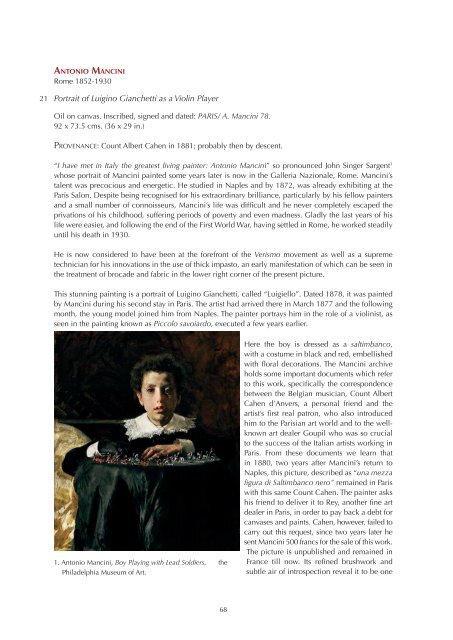Catalogue-2014-Jean-Luc-Baroni
- No tags were found...
You also want an ePaper? Increase the reach of your titles
YUMPU automatically turns print PDFs into web optimized ePapers that Google loves.
Antonio Mancini<br />
Rome 1852-1930<br />
21<br />
Portrait of Luigino Gianchetti as a Violin Player<br />
Oil on canvas. Inscribed, signed and dated: PARIS/ A. Mancini 78.<br />
92 x 73.5 cms. (36 x 29 in.)<br />
Provenance: Count Albert Cahen in 1881; probably then by descent.<br />
“I have met in Italy the greatest living painter: Antonio Mancini” so pronounced John Singer Sargent 1<br />
whose portrait of Mancini painted some years later is now in the Galleria Nazionale, Rome. Mancini’s<br />
talent was precocious and energetic. He studied in Naples and by 1872, was already exhibiting at the<br />
Paris Salon. Despite being recognised for his extraordinary brilliance, particularly by his fellow painters<br />
and a small number of connoisseurs, Mancini’s life was difficult and he never completely escaped the<br />
privations of his childhood, suffering periods of poverty and even madness. Gladly the last years of his<br />
life were easier, and following the end of the First World War, having settled in Rome, he worked steadily<br />
until his death in 1930.<br />
He is now considered to have been at the forefront of the Verismo movement as well as a supreme<br />
technician for his innovations in the use of thick impasto, an early manifestation of which can be seen in<br />
the treatment of brocade and fabric in the lower right corner of the present picture.<br />
This stunning painting is a portrait of Luigino Gianchetti, called “Luigiello”. Dated 1878, it was painted<br />
by Mancini during his second stay in Paris. The artist had arrived there in March 1877 and the following<br />
month, the young model joined him from Naples. The painter portrays him in the role of a violinist, as<br />
seen in the painting known as Piccolo savoiardo, executed a few years earlier.<br />
1. Antonio Mancini, Boy Playing with Lead Soldiers, the<br />
Philadelphia Museum of Art.<br />
Here the boy is dressed as a saltimbanco,<br />
with a costume in black and red, embellished<br />
with floral decorations. The Mancini archive<br />
holds some important documents which refer<br />
to this work, specifically the correspondence<br />
between the Belgian musician, Count Albert<br />
Cahen d’Anvers, a personal friend and the<br />
artist’s first real patron, who also introduced<br />
him to the Parisian art world and to the wellknown<br />
art dealer Goupil who was so crucial<br />
to the success of the Italian artists working in<br />
Paris. From these documents we learn that<br />
in 1880, two years after Mancini’s return to<br />
Naples, this picture, described as “una mezza<br />
figura di Saltimbanco nero” remained in Paris<br />
with this same Count Cahen. The painter asks<br />
his friend to deliver it to Rey, another fine art<br />
dealer in Paris, in order to pay back a debt for<br />
canvases and paints. Cahen, however, failed to<br />
carry out this request, since two years later he<br />
sent Mancini 500 francs for the sale of this work.<br />
The picture is unpublished and remained in<br />
France till now. Its refined brushwork and<br />
subtle air of introspection reveal it to be one<br />
68
















